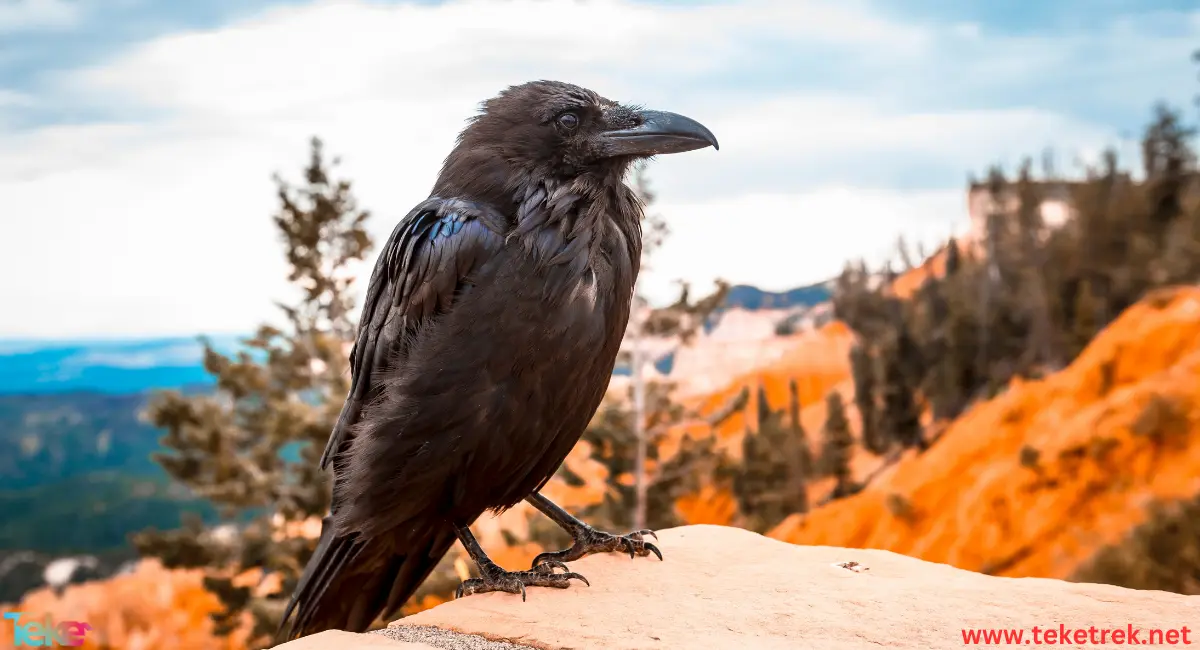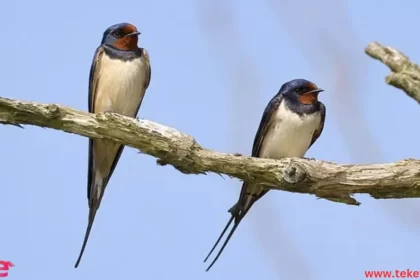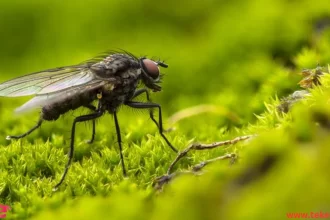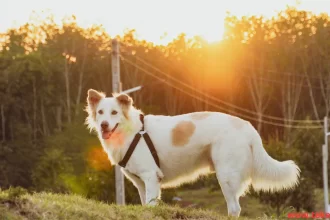The crow is considered one of the most intellectually advanced bird, blending intelligence with quick learning abilities. It excels in skillfully using tools and adeptly constructing them. The crow is a friend to farmers, showcasing its ability to consume pests and insects, contributing to maintaining the balance of nature in a helpful and efficient manner.
Scientifically known as “Corvus,” this genus encompasses several diverse species distributed across various parts of the world, rom teketrek we will talkmore about it.
Crow specifications
The crow is vertebrate animal generally characterized by black feathers, with variations in shades of color and some color differences among species.
- Its body is slender, with a straight tail, and it possesses a strong, sharp beak adapted for consuming a variety of foods.
- The crow’s relatively small head compared to its body is often accompanied by a slim neck. The size of crows varies from small to large, with a body length ranging from approximately 34 to 70 cm, extended wings, and a weight of about 0.7-1.4 kg.
- Its legs are powerful and equipped with sharp claws, enabling the crow to grasp prey and navigate surfaces. With long, straight wings, the crow can fly efficiently and control its directions easily.
- The crow has relatively large eyes, often dark in color. Considered intelligent birds, crows demonstrate the ability to use tools and effectively solve problems.
- Known for its straight and fast flight, the crow can adapt to a wide range of environments. Some crows can live for approximately 20 years.

Wonders of the Crow
Considered one of the most intelligent creatures on Earth, the crow demonstrates remarkable cognitive abilities and problem-solving skills.
- Studies have shown that crow brains compare in relative size to the functionally equivalent cortex in chimpanzees and humans.
- It possesses the ability for rapid learning and adaptation to the environment.
- It relies on a complex communication system involving sounds and movements, enabling social interaction within its group.
- The crow has an outstanding ability to distinguish between objects and faces, and it also exhibits excellent memory for food locations and important places.
- Studies have revealed that crows have the ability for visual recognition of humans and can convey information about “bad” humans through vocalizations. Crows seem to show appreciation for humans by offering them gifts.
- The crow demonstrates the ability to innovate new solutions to the challenges it faces, whether related to obtaining food or interacting with the environment.
- Crows exhibit distinctive play behaviors that highlight their intelligence and social interactions.
The crow cooperated with the wolf
Crows coexist and interact with wolves visibly. This interaction is related to food search, where crows use their calls to inform wolves when there is injured prey. Consequently, this cooperative relationship becomes particularly noticeable in winter, with crows consistently associated with wolf packs throughout this season.
Crows and wolves engage in building relationships, playing with wolf pups using sticks, or flying around them.
The origin and lineage of the crow
The crow belongs to the family of birds known as Corvidae and is an integral part of the raptor bird heritage. It is found across various parts of the world, with its origins dating back to ancient times, where it was respected and associated with many cultures.
Categorized under the family “Corvidae,” crows are part of the corvids, which also include the hooded crow and the carrion crow. This family is characterized by intelligent thinking and social interactions.
Crow’s house
Crows inhabit a diverse range of environments, ranging from forests to urban areas.
- They are found in meadows and fields, where they can search for insects and grains as part of their diet.
- The presence of crows is noted in coastal and aquatic regions, where they can benefit from diverse food sources.
- Crows can be found in mountainous areas, adapting to rugged terrains and taking advantage of available food resources.
- They inhabit agricultural regions, where they can find insects, worms, and grains.
Crow reproduction
Crows are non mammal animal, it reach sexual maturity at the age of three for females and five for males.
- Generally, male and female crows often share a similarity in appearance, but observers can distinguish them based on body size and beak size.
- The breeding season varies depending on the crow species and geographical location, with spring typically being the prime time for reproduction.
- Crows usually build their nests in elevated places such as forest trees or tall structures in urban areas. They use branches and other materials to construct the nest.
- The female lays several eggs in the nest, and the number of eggs generally ranges between 3 and 8, depending on the crow species.
- The female incubates the eggs for a period usually ranging from 18 to 21 days. The mother continues to care for the newly hatched chicks after incubation.
- The chicks grow rapidly and learn to fly and use tools from their parents. They remain with the mother for an extended period after hatching to learn essential life skills.
Crow food
The crow is Marian animal it’s diet is diverse and depends on the available resources in the region where they live, making them adaptable and varied in their food choices.
1. Crows feed on a wide range of insects and worms, and they also consume grains and seeds available in meadows and fields.
2. They consume fruits and berries, whether available in forests or urban areas.
3. Crows feed on meat, sometimes consuming carcasses of dead animals, enhancing their role in environmental cleanup.
4. In some cases, crows may prey on bird eggs or attack young birds to obtain food.
5. Crows may hunt weak young animals from other species as part of their diet.
6. They benefit from bread and human food in urban areas.
Types of crows
There are several species of crows belonging to the genus Corvus. Some of them are found in various regions around the world. Here are some well-known species:
1. Carrion Crow: Commonly distributed across different parts of Europe and Asia.
2. Hooded Crow: Inhabits parts of central and northern Europe and central Asia.
3. Common Raven: Found in wide areas of North America, Europe, and Asia.
4. Japanese Crow: Resides in Japan and its surrounding areas.
5. Australian Raven: Found in Australia.
6. House Crow: Inhabits South and Southeast Asia and parts of the Middle East.
7. American Crow: Spread across North America.
8. Norwegian Crow: Found in Norway.
9. Pied Crow: Lives in parts of Africa.

Ways of Communication Among Crows
Crows are highly intelligent birds endowed by God with great mental capacities and an organized way of life. They even played a role in teaching humans at the beginning of creation. They use various methods to communicate, such as sounds and signals:
- Crows use a wide range of vocal calls to communicate, such as warning calls or social calls.
- They employ visual signals, like feather or head movements, to communicate—each movement carries a meaning that humans cannot understand.
- Crows use behavioral communication, such as aggressive posturing or social gestures to attract attention.
The Crow as a Cultural and Historical Symbol
The crow is a cultural and historical symbol in many cultures worldwide. In ancient civilizations like Greece, the crow symbolized gods and cultural beliefs. In Greek mythology, it was considered a messenger of the gods, especially Apollo, the god of the sun. In Norse mythology, crows symbolized wisdom and intelligence and were associated with the god Odin.
In modern Western cultures, the crow is often linked to destruction and death, but also intelligence and wisdom. In Japanese culture, it symbolizes good luck and protection. Literature often uses the crow as a symbol of death or wisdom, as in Edgar Allan Poe’s poem “The Raven.”
Environmental Influences on Crow Behavior
Crows are affected by their environment, and changes in their surroundings can alter their behavior, such as foraging or adapting to new settings. Some environmental effects include:
- Climate change can affect the availability of food and water, leading to behavioral changes.
- Environmental destruction may result in the loss of natural habitats, affecting both social structure and behavior.
- Shifts in the ecosystem can impact the social composition of crows.
Keeping Crows as Pets
Keeping crows as pets can be a unique and exciting experience. They can form strong bonds with their owners and interact extensively. However, they require much care and attention, as well as knowledge of their needs:
- Crows need a varied diet including fruits, vegetables, and proteins.
- They require ample space for flying and movement.
- They need social interaction—either with humans or other birds—as they are social creatures.
Challenges include:
- Crows can be very noisy, which might cause issues in residential areas.
- They may be destructive if not given a suitable environment.
- They require specialized veterinary care, which can be costly.
Why is the Crow Considered Intelligent?
God created the crow with remarkable intelligence and comprehension. It has been taught many skills such as:
- Using tools (like sticks) to retrieve food from tight spaces.
- Logical thinking and smart problem-solving.
- Complex social interactions.
- Utilizing varied vocal calls and visual signals.
- Quick learning and adaptability.
- Excellent memory for places and objects.
- Using rocks to crack eggs or nuts.
- Planning ahead and storing food for later use.
The Relationship Between Crows and Nature
Crows are integral to nature and capable of adapting to various environments—from forests to cities. They play a significant role in ecosystems:
Why Do Crows Prefer Living in Cities?
Crows are social and highly adaptable, thriving even in urban settings due to:
- Abundant food sources like garbage and waste.
- Relative safety and infrastructure that supports health and survival.
- Safe nesting sites such as trees, rooftops, and buildings.
- Ability to adapt and thrive in city environments.
Protecting Crows from Extinction
Due to their unique lifestyle and behavior, crows face various environmental and human-related threats. Strategies to protect them include:
- Preserving natural habitats like forests and biodiversity.
- Reducing pesticide use and environmental pollution.
- Regulating hunting and educating the public on their importance.
- Raising awareness to prevent overhunting.
Benefits of Crows in Maintaining Environmental Balance
Crows play vital roles in ecosystems. Here are their benefits:
- Pest control by eating insects like locusts and cockroaches.
- Reducing worm populations that harm plants.
- Consuming carrion to clean the environment and reduce disease.
- Minimizing foul odors from decaying matter.
- Helping in seed dispersal, promoting plant diversity.
- Supporting forest health by eating harmful insects and worms.
The Evolution of Crows Through the Ages
Crows are ancient birds that have evolved into highly intelligent and adaptable creatures:
- They have existed for millions of years.
- Adapted to diverse environments from forests to cities.
- Developed problem-solving and tool-use skills.
- Became socially complex and interactive.
- Show genetic diversity allowing adaptation.
- Fossils indicate their ancient presence.
- They have a long evolutionary history as one of the most successful birds.
Factors Affecting the Life of Crows
Several factors impact the lives of crows, including:
- Climate change affecting food and water.
- Environmental destruction reducing habitats.
- Hunting affecting their numbers.
- Pollution harming their health.
- Competition and interaction with other birds.
- Human interference, both harmful and protective.
- Diseases and injuries affecting their survival.
The The crow in Cultures Around the World
The The crow has appeared in many civilizations, as evidenced by the clues and artifacts left behind by ancient cultures. It has been featured in Greek mythology, Islamic culture, and Western folklore in the following ways:
- The The crow in Greek Mythology:
The Greeks did not allow The crows to land on the Acropolis temple, believing the bird to be a harbinger of doom. They also thought that if a The crow landed on the roof of a Greek house, it signaled the death of one of its residents. - The The crow in Islamic Culture:
The The crow is mentioned in the Qur’an in the story of the two brothers, Cain and Abel, where the The crow teaches Cain how to bury his brother after killing him. The The crow is also mentioned in the Torah and the Bible. - The The crow in Western Folklore:
It is said that the The crow visits Hell in the summer, offering its feathers to the devil, and disappears from sight during this season—before people understood bird migration. In Greek history, the The crow symbolized purity and chastity, while some Europeans believed that a The crow’s caw was an omen of death. In Swedish folklore, The crows are believed to be the spirits of murdered souls.
Genius or Myth?
We can compare The crow behavior to intelligence experiments, such as tool use, puzzle-solving, and facial recognition, as follows:
- The crows possess extraordinary intelligence, comparable to that of a seven-year-old child. God has endowed them with exceptional abilities that distinguish them from other birds.
- The crows use tools, like sticks, to retrieve food from narrow spaces.
- They solve puzzles, such as using rocks to crack open eggs or nuts for consumption.
- The crows remember faces well and can distinguish between different humans with ease.
- They exhibit logical thinking, complex social interactions, adaptability, quick learning, and strategic food storage.
The crow Language: Can The crows Talk?
The crows have complex communication systems used daily within their groups. Their sounds vary depending on the situation, and The crow communication includes:
- The ability to learn and mimic over 100 different sounds, such as human speech, bird calls, animal noises, and machine sounds.
- Daily use of vocalizations, calls, caws, and signals to communicate with each other.
Bizarre The crow Behavior
There are many common behaviors observed among The crows across all continents. These include:
- The crow Courts:
The crows hold “trials” when one commits an unusual or aggressive act, such as stealing food from chicks, destroying nests, attacking another’s mate, or invading another’s territory. The group gathers to judge the offender, and punishments may include pecking to death or plucking feathers until the The crow can no longer fly. - Funerals:
The crows hold funeral-like gatherings when one of them dies. They bury the dead The crow and cover it with soil. - Collecting Shiny Objects:
The crows are fascinated by shiny things, likely because they resemble bird eggs, which they prefer. - Food Storage:
The crows store food like insects and worms in trees, on the ground, or in hidden bags to eat later when hungry, keeping it away from predators.
The The crow in Art and Literature
The The crow has been widely represented in artistic and literary works across cultures:
- In American Literature:
The The crow symbolizes death or wisdom, as in Edgar Allan Poe’s poem The The crow, known for its classical tone, supernatural atmosphere, and musical style. The poem references mythological, religious, and folkloric themes. - In Ancient Greek Civilization:
The crows symbolized deities and religious beliefs and were considered messengers of the gods, especially Apollo, the sun god. - In Japanese Culture:
The crows represent protection, safety, and happiness. - In Modern Western Culture:
The The crow symbolizes death and destruction.
The The crow’s Role in the Ecosystem
All living organisms play an important role in preserving the ecological balance. The crows help the environment in the following ways:
- Cleaning the Environment:
The crows feed on dead animals, helping prevent disease from decaying meat. They also help control animal populations by eating their young and eggs, reducing overpopulation. The crows themselves are prey for predators like snakes, crocodiles, hawks, and eagles. - Controlling Harmful Pests:
The crows contribute to forest regeneration by perching in trees and hunting harmful insects and worms. - Redistributing Seeds:
The crows help redistribute plant seeds using their beaks, making them essential allies for farmers.
Differences Between the Common The crow, American Crow, and Carrion Crow
These similar The crow species each have unique traits that distinguish them:
- Traditional The crow:
Grows up to 64 cm long, weighs about 1.5 kg, and can live over 23 years in the wild. - Common The crow:
Found in western North America, the northeastern U.S., and mountain cliffs. It has a large beak and is bigger than the American crow and the Chihuahuan The crow, weighing between 0.5 and 1 kg. - Carrion Crow:
A large, fully black bird widely distributed across the Northern Hemisphere. It has thick legs and a strong black beak.
Can The crows Be Kept as Pets?
Many young people wonder if The crows can be raised at home as pets. While The crows have unique qualities, there are challenges:
- They are large birds that need ample space to grow and fly daily. Their loud calls can disturb neighbors.
- The crows become aggressive without proper environmental conditions.
- They need regular veterinary care.
- Some people who have raised The crows describe them as affectionate and intelligent birds that form strong bonds—but they require intense care and attention.
- Despite their intelligence, The crows are still wild animals. They eat meat, fruits, and vegetables like other wild creatures.
How Do The crows Recognize Their Enemies?
The crows possess impressive abilities to identify threats:
- They have an exceptional memory for faces and complex social systems.
- The crows can track and retaliate against their enemies. They also hold funerals for fallen group members.
- They fear no predators and are known for bravery and boldness.
- The crows can categorize humans based on past actions, distinguishing between friend and foe with impressive cognitive accuracy.
What Can We Learn from The crows?
There are unique skills that humans can learn from The crows, as they exhibit remarkable intelligence and ideal behavior patterns:
- The crows can count numbers like humans.
- They recognize faces and remember who helped or harmed them.
- They taught humanity how to bury the dead, as seen in the story of Cain and Abel.
- The crows are among the most loyal birds, mating for life with one partner and not remarrying, even after the partner dies.
- They continue to feed their young until they reach adulthood, serving as outstanding parental role models.
FAQ
- What is special about the crow bird?
The crow has the largest brain among its fellow birds.
- Why is crow called crow?
The name crow is derived from the Latin word corvus.
- What does crows eat?
The crow is a carnivorous animal that feeds on birds, insects, fish, spiders, snakes, snails, and eggs. It also eats fruits and vegetables. In addition, it may eat carrion. It may search for dead animals and garbage.
generally
The crows appear as intelligent and diverse birds, adapting to various environments worldwide. These birds possess unique qualities, such as their high intelligence and species diversity. Crows play a significant role in the environment, contributing to pest control and reflecting an interaction with the habitats they inhabit. Understanding their various aspects highlights the crow as an ecologically and culturally important entity, sparking curiosity among researchers and carrying numerous stories and myths across different cultures worldwide.





